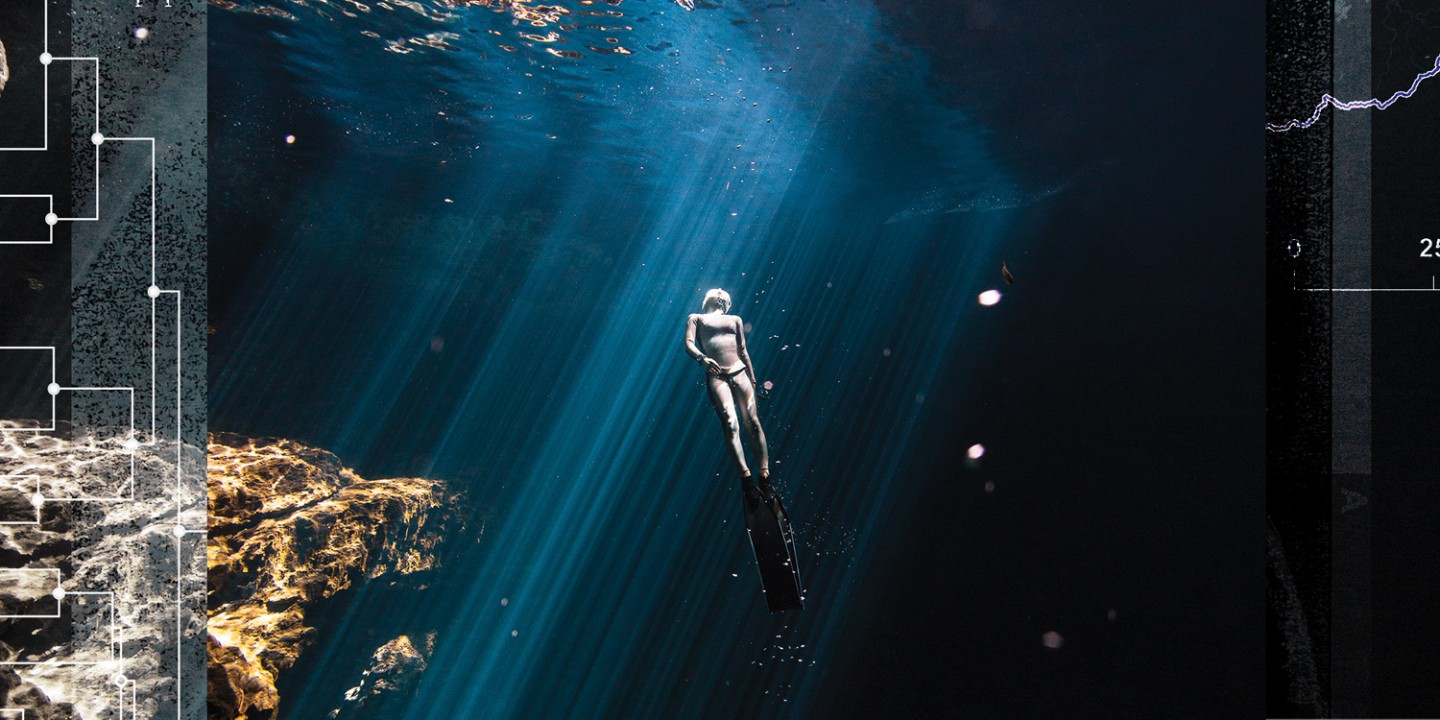God’s underwater language
As a marine biologist, I ask how—and dance at the edge of asking why.

(Century illustration / Source images: Getty & courtesy of the author)
Free diving is like scuba, but without a tank or gear. You simply float at the surface, breathe deeply to slow the blood in your veins, and hold your breath as you kick down. It’s an intense meditation: tuning in to your body and trusting your lungs to carry you 30 or 50 feet below.
Then, you’re underwater. Without the hiss of a regulator, you swim alongside fish close enough to brush fins. You observe—schooling patterns, predatory chases, the way sea fans sway and bend with the gentle surge. Mostly, you listen. On my first free dive, I discovered that the ocean has its own sound. The popping of coral polyps, like a million tiny soda bubbles. The crusty nibble of parrotfish munching algae. Beneath it all, something deeper: a hum, a subtle vibration. It’s the sound of millions of gallons of water sliding over the crust of the earth, an ancient throb like a heartbeat. You feel it as much as hear it, like the vibrating om at the start of a yoga class.
Read our latest issue or browse back issues.
The om of the sea sounds to me like the language God might speak if God chose to take an earthly voice. I’m reminded of an image from Richard Rohr: “Contemplative prayer is like striking a tuning fork. All you can really do in the spiritual life is resonate to the true pitch, to receive the always-present message.” Light, like sound, travels in resonant waves. Particles move with synchronized frequency, oscillating through water and air. As I float, buoyed and rocked by an underwater current, I can almost see the equation—f(x − vt) = A cos [k(x − vt) − φ], the mathematical description of a wave—on the blackboard of a physics class.
These waves have been propagating since the beginning of energy and matter. The om resounds, whether I hear it or not. Same, too, with everything under the sea. The coral isn’t here for display. The sea fans are purple and orange, but not merely for decoration. Everything on this reef evolved with a function and purpose, shaped by forces of competition and selection and predation and death, filtered through a funnel of chance and probability. Today, there’s a reef. The diversity of shape and color happens to be beautiful. But beauty wasn’t the point. Life goes on all day and night, in depths we have yet to fathom, in corners of the sea where humans will never lay eye.
Abraham Joshua Heschel writes, “Wonder is a state of mind in which we do not look at reality through the latticework of our memorized knowledge; in which nothing is taken for granted. . . . We are amazed at seeing anything at all; amazed not only at particular values and things but at the unexpectedness of being as such, at the fact that there is being at all.” Being, he says elsewhere, “is unbelievable.”
This is a fact that my scientific investigation shows me, day after day. It’s why I return to laboratory and field site, pulled by the wonder that close observation unlocks. In the face of such amazement, I find that language often fails. Words can’t capture the abundance or articulate my overwhelming urge to praise. So my mind returns to the wonder itself: the lingering image and feeling of being on the reef. I see it in layers. I glimpse the whole: entire food webs, cascading interactions between fish and plankton and corals and sunlight. I see the particular: a single manta ray gliding through water, wings rippling with the same sinusoidal undulation f(x − vt) = A cos [k(x − vt) − φ] as waves of sound or light.
I feel keenly what Heschel describes as “an innate sense of indebtedness.” A question is being posed to me by the reef, and I don’t know how to answer, but I do know that something within me must respond. So I study science. My work becomes a prayer of sorts: an act of regular petition, in which the point is not always direct reply but joining in conversation. By asking “How?” I dance constantly at the edge of “Why?”—and the asking, itself, is enough.
For my senior thesis in college, I “discovered” a new species. Percina freemanorum is a freshwater darter, small and brown and unassuming, one of dozens of similar fishes in the Mobile River Basin of Georgia, Alabama, and Tennessee. For a long time, scientists assumed that P. freemanorum belonged to a closely related species, the bridled darter (Percina kusha). But it turns out that P. freemanorum is genetically and physically distinct. P. freemanorum fish have, on average, fewer lateral line scales, fewer transverse scale rows, and more pectoral fin rays than P. kusha. The two species don’t share any mitochondrial haplotypes, and genomic clustering analysis shows that they’re two separate clades (distinct branches on an evolutionary tree). I know all this because I gathered the data: counted scales and measured fins, pipetted and centrifuged and lysed and sequenced hundreds of samples of DNA.
In the world of phylogenetics, it’s important news: the identification of a new species using next-generation whole-genome sequencing (ddRADSeq). It’s thrilling. I look at my name on the paper and think: I just discovered a species no one else has ever named. My work is a recent step forward in our quest to name and describe the diversity of life.
But I also have qualms about the word discovery. It suggests a kind of newness and originality that doesn’t match what really happens when we describe a species. If our molecular timescale analysis is correct, P. freemanorum diverged from P. kusha over half a million years ago. The darters weren’t waiting around for us to name them as a species. Fish compete or mate or coexist (or not) according to simple biological rules and urges, regardless of our categories or definitions. Discovery doesn’t imply the act of creating or producing or changing. Instead, discovery is a slow uncovering of what was there all along.
The semester I worked on my thesis, I came across a quote by Rohr: “God always and forever comes as one who is totally hidden and yet perfectly revealed in the same moment or event.” The quote lingered in my mind, and I began to see the process of species discovery—those months of gene sequencing and data analyzing and fin counting—as an example of what hiddenness and revelation look like.
I began my research with some jars of dead fish labeled P. kusha. At first glance, these fish—slowly degrading, ethanol-reeking blobs of tissue—told us nothing. Thus began a three-semester odyssey to uncover their story. Are all these P. kusha a single species? Or are specimens from different rivers distinct?
In the process of answering, I altered the fish beyond recognition. Raw fin clips became microliters of dissolved DNA. DNA turned to the lime-green products of PCR. Tiny dots of liquid were loaded onto plates, shipped to sequencing facilities, turned into files of indiscernible data so complex they require external computer clusters to process. From there, I wrote string after string of code, aligned thousands of sequences, pressed “run” on bioinformatics programs, crossed my fingers, and (saying a little prayer) waited. Finally, one day, the programs finished. Out popped a phylogenetic tree.
It didn’t look like much. Rough, pixelated, messy. Not even close to a polished figure to share with the world. But what appeared on my computer screen felt, in the moment, the way I imagine it might feel to receive a message from God. A process that began with pieces of fins culminated in a figure showing the relationships of real living things. This figure has the power to tell us how the genes of some fish are different from others. It tells us how organisms sort themselves into groups. The tree brings order and pattern and meaning to what was previously nothing more than a vial of dead fish.
There’s a story hidden in every living thing. Totally concealed yet perfectly present—literally etched in the nucleotide sequences of every cell, if we only tune in. We approach these stories through science—deduction, experiment, observation—but also through participation and presence.
There is something else, too, that unites every living thing. I can’t always name it like I named the P. freemanorum, but I think of it like the om of the sea that reminds us that a story lives in our own cells and resounds through our own bodies, inviting us into relationship with species and systems, calling us toward the wonder of that which is larger than the self.
* * * * * *
The Christian Century's community engagement editor Jon Mathieu engages author Emily Boring in conversation about her article and how she reconciles science and faith which are sometimes assumed to be in conflict.





